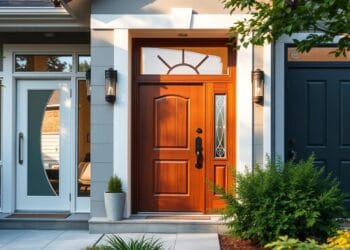A Bird’s Eye View
Our homes’ safety is paramount in our fast-paced lives, serving as a cocoon against potential hazards. Despite thriving metropolitan environments or tranquil suburbs, fortifying our residences sits high on our priority list. Nevertheless, an inevitable query nags at the corners of our minds, “What amount do I need to part with to integrate an average home security system?” This narrative aims to debunk this mystery, spinning a comprehensive account around the myriad expenses of installing a security system. It delves into equipment costs, installation charges, and hidden outlays and provides guidance on economizing without compromising quality.
Decoding Home Security Systems
Home security systems are interconnected devices choreographed to guard your dwelling against intruders, fire, and other emergencies. These systems can exhibit stark contrasts – from rudimentary configurations with a handful of sensors to tech-intensive implementations multiplying cameras, alarms, and smart home compatibilities.
The Building Blocks of Home Security Systems
- Cameras: Surveillance and observation-centric tools.
- Sensors: Instruments discerning motion, door/window breaches, and broken glass incidents.
- Alarms: Generate warnings to dissuade interlopers and alert proprietors.
- Control Panels: The nucleus for directing the security system.
- Smart Home Synergy: Melds with other intelligent appliances for superior performance.
Classifying Home Security Systems
- Cabled Systems: Mandates tangible wiring to stitch components.
- Wireless Mechanisms: Capitalize on Wi-Fi or cellular signals for seamless connectivity.
- DIY Implementations: Installed and supervised by house owners independently.
- Professionally Installed Systems: Fitted and observed by security organizations.
Variables Governing the Expense of Home Security System Integration
Multiple variables conspire to determine the cost of installing a home security system. A clear grasp of these elements can steer you toward knowledgeable decision-making and prudent budgeting.
The Category
- Wired vs. Wireless: The higher labor involvement makes wired systems significantly costly, as cables must be threaded through walls. Wireless mechanisms may be easier to incorporate but represent a more maintenance-hungry beast.
- DIY vs. Professional Installation: While the DIY route can be a savior in terms of installation costs, it might disappoint in innovative features and dependability compared to professionally installed systems.
The Dimension
- Small Apartments: Fewer working parts and less labor translate to reduced costs.
- Large Houses: The requirement of additional sensors, cameras, and potentially several control panels inflates the total expenditure.
Component Numbers
- Cameras: Cameras yielding high-resolution results with night vision and motion detection compatibilities may be heavier on the pocket.
- Sensors: The more the access points requiring fortification, the loftier the cost.
- Alarms and Control Panels: Supplementary costs may creep in due to the presence of advanced control panels with touchscreen capabilities and smart home synergies.
Brand and the Quality
- Luxury Brands: Promise high-tech features, superior reliability, and extended warranties, albeit with a higher price tag.
- Economical Alternatives: Score high on affordability, albeit with possible compromises on advanced features and durability.
Additional Perks
- Smart Home Integration: The security system can be piloted through a mobile application or voice assistant.
- Monitoring Services: Professional monitoring can ideally call the authorities when an emergency ensues but includes a constant subscription cost.
- Surplus Security Attributes: Panic buttons, environmental sensors (smoke, carbon monoxide poisoning), and video-enabled doorbells might add to the cost.
Demystifying Costs with an Average Breakdown
Knowing the average costs typically associated with a security system’s different facets and services can help you plan your budget for its installation.
Equipment Costs
| Components | Typical Cost Range |
|---|---|
| Cameras | $100 – $300 a unit |
| Sensors | $20 – $50 a unit |
| Alarms | $30 – $100 a unit |
| Control Panels | $100 – $500 per unit |
| Smart Home Devices | $50 – $200 a unit |
Installation Costs
- Professional Installation Costs: The ballpark figure varies between $100 and $500, depending on the system’s intricacy and the home’s size.
- DIY Installation Costs: While labor would not be billed, tools might have to be purchased, and time should be allocated for setting up the system.
Monitoring Costs
- Monthly Subscription Costs: Depending on the monitoring level and the inclusion of additional services, the cost ranges from $10 to $50 per month.
- Annual Subscription Costs: Some firms offer rebates for annual payments, charging between $100 and $500 a year.
Comparative Analysis of Diverse Home Security Systems
DIY Systems
They are popular because of their budget-friendliness and installation ease. They are the go-to for renters or homeowners who prefer a hands-on approach.
- Average Cost: $200 – $600
- Examples: SimpliSafe, Ring Alarm
Professional Systems
Equipped with innovative features, reliable output, and professional monitoring. They resonate with homeowners seeking a comprehensive security solution.
- Average Cost: $500 – $2,000
- Examples: ADT, Vivint
Mixed Systems
Hybrid systems amalgamate DIY and professional elements, establishing an equilibrium between cost-effectiveness and advanced features.
- Average Cost: $300 – $1,200
- Examples: Frontpoint, Abode
Hidden Outlays to Take Into Account
Budget structuring for a home security system must account for possible concealed costs that might spring up.
Maintenance and Repairs
- Periodic Maintenance Fees: Certain systems necessitate cyclic maintenance for optimum performance.
- Repair Costs: Deteriorated components might require fixing or replacement, which inflate the total outlay.
Upgrades and Add-Ons
- Price for Introducing New Features: As technology expands its horizons, system upgrading through feature or device addition may be desirable.
- Upgrading Existing Components: Older components might need replacements for compatibility with newer devices.
Licenses and Fees
- Local Permit Stipulations: Certain governments mandate permits for security system installations, accompanied by ancillary fees.
- Allied Costs: Permit charges can swing between $20 to $100, contingent on local ordinances.
Economizing on Home Security System Integration
Numerous strategies exist to reduce the costs of integrating a home security system without repercussions on quality.
Service Bundling
- Bundling Perks: Several firms extend discounts when security services are clubbed with other services like internet or cable.
- Illustration: Comcast Xfinity extends discounts for clubbing home security with their internet and cable services.
Exploiting Seasonal Promotions and Discounts
- Sales and Promotions: Look for seasonal sales, such as Black Friday or holiday promotions, to find deals on equipment and installation.
- Instance: ADT frequently extends promotional discounts during significant holidays.
DIY Installation
- Savings: Home installation can drastically cut down professional installation fees.
- Benefits: DIY systems are typically simpler to upgrade and personalize.
Selecting the Right Plan
- Plan Selection: Choose a package that fits your budget and requirements. Avoid spending money on features that you don’t need.
- Case Study: SimpliSafe extends customizable packages, allowing the choice of features necessary for you.
Stark Reality: Examples and Case Studies
Instance 1: Petite Apartment
- Cost Analysis:
- Cameras: $200
- Sensors: $100
- Alarms: $50
- Control Panel: $150
- Installation: DIY (no cost)
- Total: $500
Instance 2: Sizeable Residence
- Cost Analysis:
- Cameras: $600
- Sensors: $300
- Alarms: $150
- Control Panel: $300
- Installation: Professional ($300)
- Total: $1,650
Case Study: Frugal Installation
- Scenario: A homeowner sought a cost-effective solution with robust components.
- Solution: Opted for a DIY system with elementary features and added professional monitoring.
- Cost Breakdown:
- Equipment: $400
- Installation: DIY (no cost)
- Monitoring: $20/month
- Total: $640 (First Year)
Frequently Asked Queries Regarding the Costs of Home Security System Installation
What is the most economical way to incorporate a home security system?
The most cost-cutting approach is choosing a DIY system. These systems are crafted for effortless installation, saving costs on professional installation. Look for economical brands and take advantage of seasonal promotions and discounts.
Are there ongoing costs after installation?
Yes, post-installation costs typically emanate from monitoring services. Fees for monthly or annual subscription plans for professional monitoring range from $10 to $50 per month. Additional charges might arise from maintenance, repairs, and system upgrades.
Can I integrate a home security system myself?
Yes, many home security systems are designed for DIY installation. These systems come with detailed instructions and are fairly simple to set up. DIY installation can significantly save professional installation fees and allow for better customization.
What is the asking rate for professional monitoring?
The costs associated with professional monitoring vary depending on the provider and the level of service. The ballpark figure for monthly charges swings between $10 to $50. Discounts for annual payments can bring down costs ranging from $100 to $500 per annum.
What are the indispensable features of a home security system?
A home security system should essentially incorporate:
- Cameras: For surveillance and monitoring.
- Sensors: To detect motion, door/window openings, and glass breakage.
- Alarms: To sound alerts and deter intruders.
- Control Panels: To manage and control the system.
- Smart Home Integration: For superior functionality and remote control.
The Final Word
Deciphering the average cost of home security system integration is intricate, as various facets include the system category, home size, component numbers, brand, and additional amenities. Being cognizant of these factors and potential concealed costs equips you with the armor to choose a system that fits your budget and requirements. Prioritizing home security is necessary for achieving peace of mind and protecting against potential threats.
Making a Move
We hope this expansive guide catalyzes a deeper understanding of the costs associated with home security systems. Your questions are welcome, and we invite you to contribute to the conversation with your experiences. For a free home security system integration consultation or a quote, click here.










![All about Naver TV, Apps, and Wikipedia - Your ultimate guide [2024] 9 All about Naver TV, Apps, and Wikipedia - Your ultimate guide [2024]](https://readmorebuzz.com/wp-content/uploads/2024/05/Screenshot-2024-05-22-at-05.19.22-75x75.png)